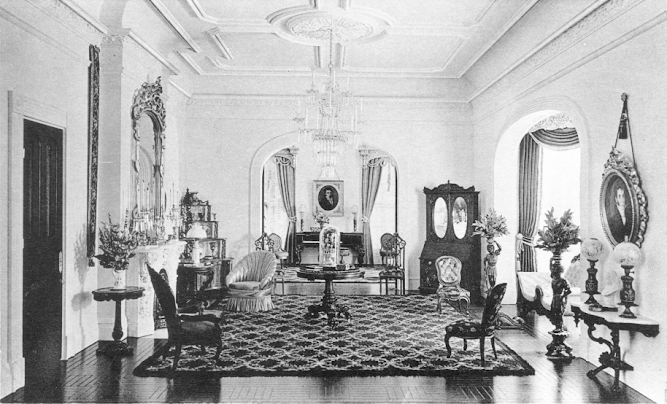The Lincoln Museum, in the heart of downtown Washington, D.C, is housed in the old Ford's Theater, where President Lincoln was assassinated. Its history may begin with Osborn Hamline Ingham Oldroyd of Ohio, an admirer of Abraham Lincoln. In his eighteenth year, during Lincoln's first campaign for the Presidency, Oldroyd was inspired by a little book, "The Life, Speeches, and Public Services of Abraham Lincoln." He was eager to learn more about this man who could reach such heights with no more than a year of schooling.
At the beginning of the Civil War, Oldroyd was one of the first to enlist when Company E, 20th Ohio Infantry, was organized in his neighborhood. He spent nearly four years in defense of the Union, upholding the principles of his hero. At the age of 22, after his discharge from the Army, Oldroyd determined to devote his life to the pursuit of knowledge about this great man. With unfailing devotion, he gathered pictures, speeches, newspaper articles, books, furniture, and other Lincoln mementos that he could obtain by gift or purchase. He sustained himself and his family by selling some of his collected relics.
 |
| Osborn Hamline Ingham Oldroyd, date unknown. |
 |
| The Lincoln's Springfield, Illinois, House. NOTE: Mary added a 2nd floor in 1856 without Abraham knowing. |
For 10 years, Oldroyd operated his "Lincoln Museum" there with rather dubious financial practices, charging a small fee for visitors and skimping Robert Lincoln on the rent. Robert Lincoln gave the family home to the state government in 1887 (for free public use), and Oldroyd was hired by the state of Illinois to be the first custodian of the house and gave him a salary of $1,000 per year. Oldroyd undoubtedly used this salary to increase his collection at every turn.
 |
| One-half of a stereo card picture of Oldroyd's Lincoln collection in "The Parlor" of the Lincoln House. |
After ten years of residence in Springfield, Oldroyd moved his collection to Washington and took up residence in the Government-owned Petersen House at 516 10th Street, northwest. This was the house into which the President was carried, across the street from Ford's Theater, after Booth's fatal shot. It was here that Lincoln died on the morning of April 15, 1865, approximately nine hours later.
When a Democratic governor was elected in Illinois in 1893, the staunch Republican Oldroyd was evicted from the Lincoln House. Luckily for Ford's Theatre, the then-owners of the Petersen House invited Oldroyd and his now-homeless collection to Washington. He set up shop in the former boarding house across the street from Ford's Theatre at the Petersen House.
 |
| This picture was taken from within the front parlor of the Petersen House, facing toward the rear parlor. The door to the right leads into the room where Lincoln died at the Petersen House. |
 |
| View from within the rear parlor of the Petersen House in the direction of the front parlor. This photo shows only the front parlor. |
 |
| Photograph shot from the entrance of the room where Lincoln died. The bed Lincoln died in would have been located in the bottom right-hand corner of this photo. |
When the U.S. government acquired the Petersen House in 1896—the government first purchased a historic home—Oldroyd continued living in the house and served as curator.
 |
| Osborn Oldroyd in front of the Lincoln Museum in the Petersen Boarding House in 1925 |
 |
| THE SIGN READS: HOUSE IN WHICH ABRAHAM LINCOLN DIED — CONTAINS THE — "OLDROYD LINCOLN MEMORIAL COLLECTION" OF OVER 3000 ARTICLES. DAY AND EVENING ADMISSION 27¢ + 3¢ TAX ● TOTAL 30¢ |
In the 1920s, Oldroyd brokered a deal with then Illinois Representative Henry Riggs Rathbone—son of the Lincolns' ill-fated guests on the night of the assassination—for the federal government to purchase the collection for $50,000 ($785,000 today).
In 1932, Oldroyd's collection moved into a repurposed Ford's Theatre, which had sat empty since several floors had collapsed in 1892. With the centennial of the Civil War approaching and plans to restore the Theatre under debate in the 1940s and 1950s, descendants of theatre owner John T. Ford and the Defense Department began to return objects pertinent to the assassination. These included the pistol used to assassinate the President and the door to the Presidential Box where Lincoln sat that night.
A 1935 guide to the Ford's Theatre Museum compared its significance to the Lincoln Memorial, saying the "Lincoln Memorial is a shrine to a great Patriot; the Lincoln Museum is primarily a memorial to the human qualities of a beloved leader."
 |
| Osborn Hamline Ingham Oldroyd (1842-1930) |
The self-appointed "Captain" Oldroyd, who was once described as a "deadbeat" by Robert Lincoln, strikes me as one of the most exciting personalities of the Ford's Theatre story—eccentric, conniving, financially unscrupulous. But he astutely figured out how to help others understand and love Lincoln as he did—through preserving and displaying objects of historical significance.
ADDITIONAL READING:
Compiled by Dr. Neil Gale, Ph.D.

















































